The Desktop Kabini Review Part 1: AMD Athlon 5350 (AM1) Tested
by Ian Cutress on April 9, 2014 8:00 AM EST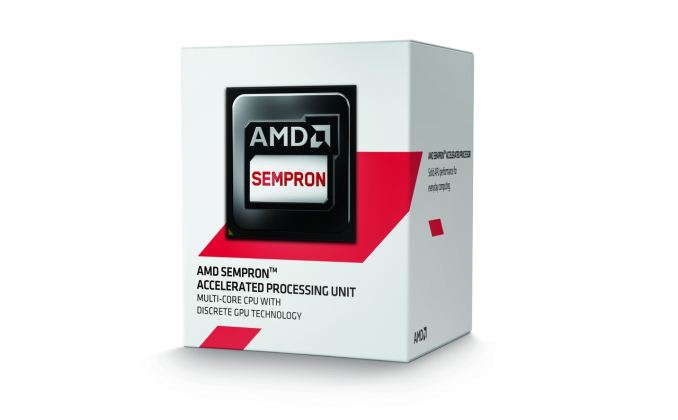
AMD announced earlier in March that it would be launching a socketed desktop Kabini APU. Traditionally the ultra low end/low power SoCs on desktops have come in packages soldered on to motherboards. If you need a faster CPU, you bought a new motherboard with it. With its new AM1 platform, AMD hopes to bring the sort of flexibility enjoyed by the rest of the desktop market to the entry level value segment.
The rationale is simple: the traditional desktop PC is under tremendous price pressure due to the popularity of affordable tablets, notebooks, Chromebooks and Chromeboxes. While there are definitely advantages to a desktop, it's a market that won't grow on its own. The one advantage desktops have over any of the aforementioned modern mainstream computing devices is upgradability. Unfortunately that's a feature that's often lost as we look at the value segment of the desktop market. AM1 attempts to fix that.
A socketed APU is useless without a lineup of APUs to swap in and out of the aforementioned socket, and that's exactly what AMD is launching today. There are a total of four AM1 APUs launching today:
| AMD AM1 Kabini APUs | ||||
|
Athlon 5350 |
Athlon 5150 |
Sempron 3850 |
Sempron 2650 |
|
| CPU Cores | 4 | 4 | 4 | 2 |
| CPU Frequency | 2.05 GHz | 1.60 GHz | 1.30 GHz | 1.45 GHz |
| GPU Cores | 128 | 128 | 128 | 128 |
| GPU Frequency | 600 MHz | 600 MHz | 450 MHz | 400 MHz |
| Memory Frequency | 1600 MHz | 1600 MHz | 1600 MHz | 1333 MHz |
| L2 Cache | 2 MB | 2 MB | 2 MB | 1 MB |
| TDP | 25 W | 25 W | 25 W | 25 W |
| Price | $55 | $45 | $36 | $31 |
Each of these APUs features up to four 28nm Jaguar cores and a 128 SP implementation of AMD's GCN GPU. We've gone over both the Jaguar and GCN architectures in previous articles, so we won't spend a lot of time recapping them here. Jaguar is the latest in AMD's line of "cat" cores, designed to go up against Intel's Atom. GCN on the other hand is a well known GPU design from AMD as well, cut down here to fit in a much smaller die area (and thermal envelope).
This isn't the first time we've seen this Jaguar + GCN combination of course. Kabini first launched as a notebook APU nearly a year ago. Architecturally we're looking at the very same SoC, even down to running at the same max clocks and at the same TDP. The big difference is what we have here today is socketed and targeted at the desktop.
The Athlon and Sempron brands are back and used for AM1 Kabini. The most expensive AM1 APU is the $55 Athlon 5350, a quad core SoC running at 2.05 GHz with a 2 compute unit GCN GPU (128 SP) running at 600 MHz. All four models will have an official TDP rating of 25W, suggesting that they are all the same die and merely binned according to performance.
While the APU costs are low, it's actually the motherboard costs that are most impressive. AMD expects mini-ITX and micro-ATX AM1 motherboards to retail for between $25 - $35. At the low end of the spectrum that means you could be looking at a fully integrated desktop platform for less than $60. Obviously you have to add in the cost of memory, storage, PSU/chassis and heatsink/fan but we're still dealing with an extremely low cost solution.
The real value in having a socketed processor is being able to upgrade the chip without incurring the cost of a new motherboard down the road. Unfortunately AMD isn't saying anything about what future APUs will support Socket-FS1b, so for now all we have is what's in the table above. Given the BGA compatibility between Kabini and Beema, I'd assume we might see a Beema FS1b upgrade at some point. However what comes after that remains to be seen.
Historically AMD has done a good job of maintaining backwards compatibility with sockets for as long as possible, the one challenge being shifts in memory technology. With DDR4 expected to ship at the high end later this year, the DDR3 based FS1b platform should at least have some life in it from a memory compatibility standpoint.
The Platform, Socket & Motherboards
While AM1 is the name of the platform, FS1b is the name of the new socket. AMD sent along a Gigabyte AM1 micro-ATX board (the GA-AM1M-S2H):
The AM1 platform makes for incredibly simple motherboards. There's hardly anything down on the board itself as Kabini is a full blown SoC with integrated memory, PCIe, USB, Gigabit Ethernet and SATA controllers. Gigabyte threw down an iTE Super I/O chip on the motherboard (beneath the heatsink in the lower left) to add serial, LPT, and PS/2 keyboard/mouse ports.
The key points to note here are:
- Single Channel 64-bit DDR3/DDR3L
- Two USB 3.0
- Eight USB 2.0
- PS/2
- Trusted Platform Module Support
- Up to four eDP/DP/HDMI video ouputs
- VGA output
- Four PCIe 2.0 lanes for a discrete GPU/PCIe device
- Two SATA 6 Gbps ports
- One PCIe 2.0 x1 lane allocated to an Ethernet controller
- Three PCIe 2.0 x1 lanes for other controllers (SATA, USB, LAN, WiFi, PCIe 2.0 x1 slots, PCIe to PCI bridges)
As you can see, Kabini provides a good amount of IO. The Gigabyte board includes a single PCIe x16 slot (x4 electrical) and two x1s. You also get two USB 3.0 ports and two USB 2.0 ports on the back header, although the APU itself can support up to 8 USB 2.0 ports. There are also two 6Gbps SATA ports down on the board, the maximum supported by Kabini.
The audio solution has to be cheap to be viable, and we get an ALC887 Realtek codec, which is actually higher end than I expected. Realtek are said to offer a discount when an audio codec and network controller are bought for the same product, so it is no surprise to see a Realtek NIC equipped here.
Because AM1 is a drive to low cost platforms, I do not see many motherboard manufacturers taking advantage and producing works of electrical engineering art. When the most expensive APU you can purchase for a platform is $55, when a motherboard manufacturer starts considering extra controllers or fancy features, the cost/benefit analysis might go out of the window. An extra USB 3.0 controller might add $0.75 to the bill-of-materials, require extra validation and optimization, then add a final $2.50 to the end-user cost (or $4 after retailer markup). After speaking with Patrick from ServeTheHome about the platform, there is certainly scope for adding several NICs to the motherboard and combining its use both as a PC and a router, however none of the motherboards being released with AM1 at launch seem to have more than one.
I was told by AMD that AM1 systems should support memory overclocking above the verified DDR3-1600 speed. This should allow the integrated graphics to stretch its legs a bit more despite the presence of a single channel memory controller should a system integrator consider buying faster memory. Unfortunately at least the Athlon 5350 seems locked to a max multiplier of 20.5x, so there's no hope for easy overclocking of this part at least.
On day one, motherboards should be available from the following vendors:
Once the products are in the market we will attempt to go over them all in one of our motherboard previews, and perhaps a few in full reviews.
With a new socket comes a new heatsink mounting system. Although the rest of AMD's desktop sockets still rely on a latch + lever retention system, Socket-FS1b moves to a push-pin design similar to what Intel uses on its motherboards (albeit with fewer mounting holes, and much simpler mounting/removing due to lower retention force requirements).
At 25W TDP, we might have been hoping for a passive solution, and I am sure that one of the CPU cooler manufacturers will make one, but AMD is playing it safe by using a small active low profile stock cooler. I would hazard a guess that this is an all aluminium construction in order to keep costs down. The reference AM1 HSF is oddly reminiscent of what old "high end" CPUs used to use years ago.
Most AM1 platform motherboards will be similar to what we have here. Some will ship with DisplayPort/DVI, and others might have an extra USB3/SATA controller. I doubt we will see any with audio codecs above the ALC892, or Killer NICs, although there might be an Atheros in the mix.


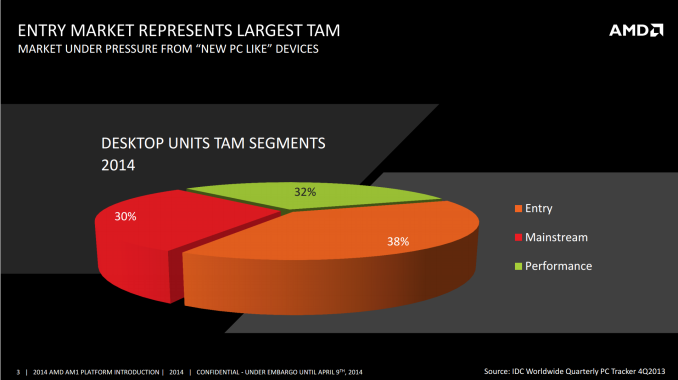
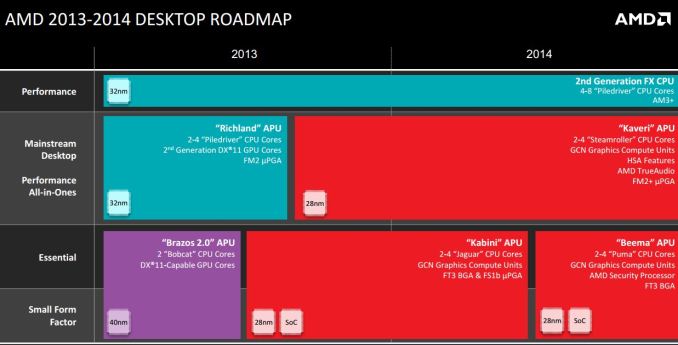







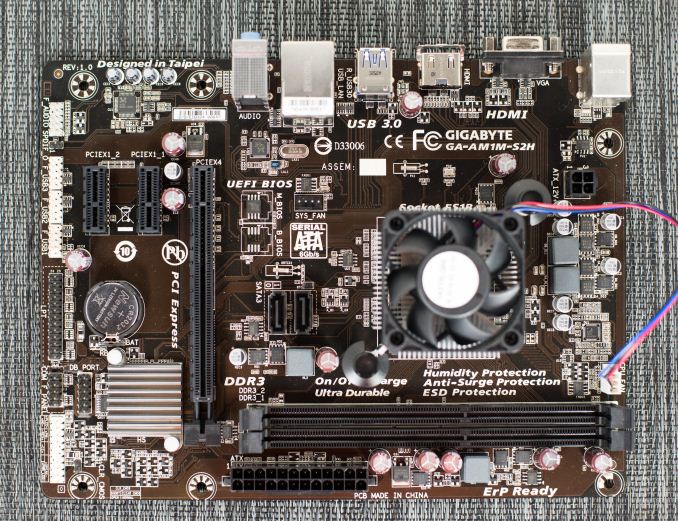
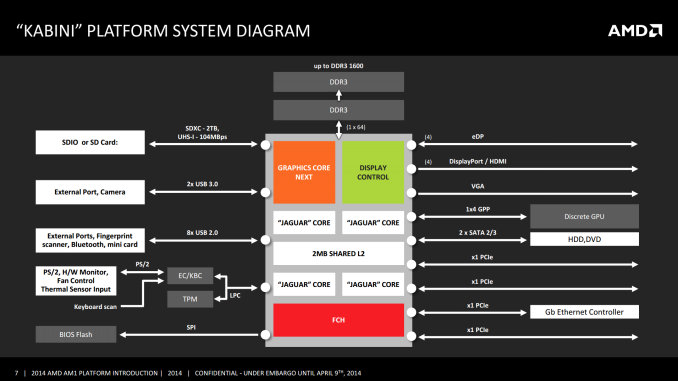
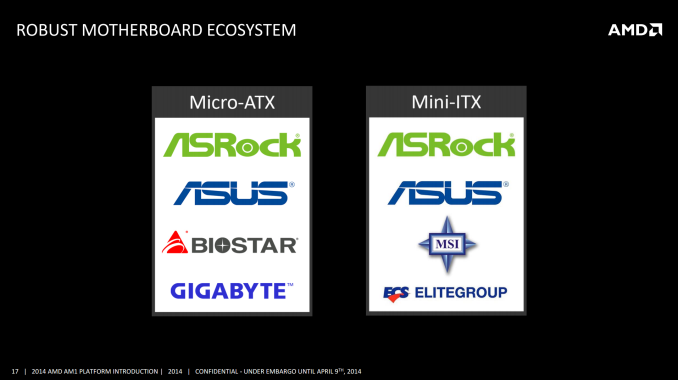
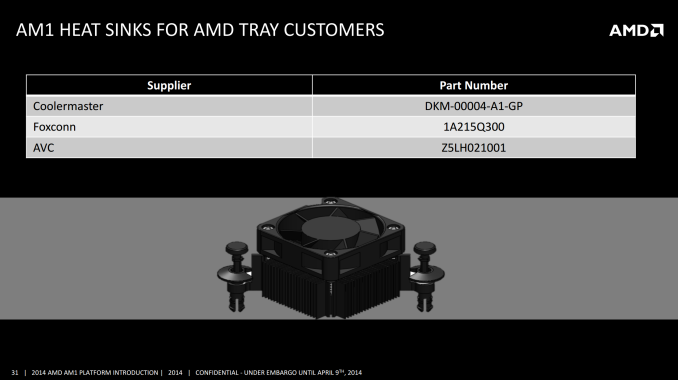
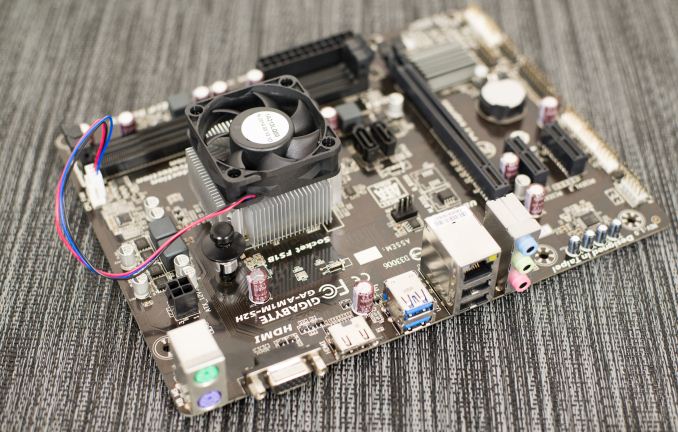
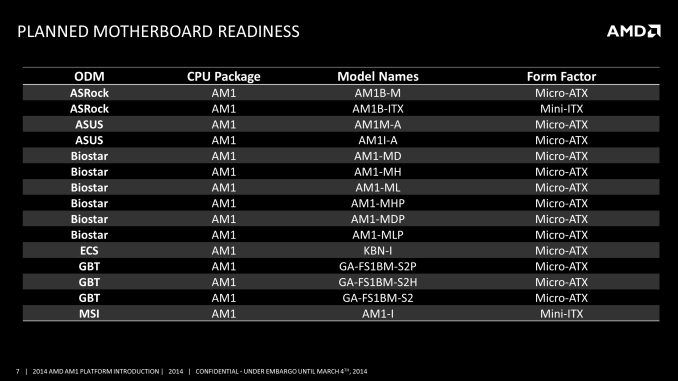








126 Comments
View All Comments
azazel1024 - Thursday, April 10, 2014 - link
Dear gods yes. Taking DC-DC from a laptop power brick would be awesome. Heck, especially the Intel systems are probably looking at 40-50w absolute max, even with a drive or two in there.Considering there are many 90w power bricks...seems like it could take 12v in no problems.
For the commenter who posted the Tom's review on power numbers who seems to be indicating little difference in power consumption...that 3.5w figure, looking at TOTAL PACKAGE power consumption, is greater than a 10% difference at idle and the figures under load are more like a 30-40% difference in power consumption.
Since I assume the board and other bits add a fair amount here, the CPU difference is looking like probably double the CPU idle power consumption and triple the CPU load power consumption for the Kabini versus Bay Trail.
Also, the power consumption figures on both systems are crap. My full up mATX G1610 uses less power at idle and under load than the Kabini system uses and mine even uses less power than the Bay Trail based one at idle. So either the boards and devices attached are total crap, or else they are using one huge and power inefficient PSU to test with. Heck, mine isn't even all that great, a 380w Antec Earth watts bronze rated. Something like a 360w Seasonic gold would probably drop my idle power under 20w from the 21w it is now and load to under 45w.
So my guess is a big, power inefficient PSU, at the least and maybe just crappy component selection too.
No matter what though, Kabini doesn't look good there, in comparison to Bay Trail or in comparison to an Intel "55w TDP" processor either...which has oodles more CPU performance.
mikato - Friday, April 11, 2014 - link
I agree, the PSU is really important here. A big PSU will be inefficient for a low power system even if it's a 80 PLUS Gold or something.ruthan - Thursday, April 10, 2014 - link
Simply slug, this HW is already dead.25W is too much for netbook or tablet, and for NAS or HTPC are Corei3 much better choice. GPU performance is also worse that IntelHD4000.
azazel1024 - Thursday, April 10, 2014 - link
I am tossing around the idea of a core i3 for my next server depending on exactly what Cherry/Willow Trail and Broadwell/Skylake might hold.The extra cost might be worth it for, what might be, significantly better performance at not significantly higher power consumption during "normal work" which is idle or streaming.
Otherwise, back to a Broadwell/Skylake based entry level celeron probably. The price and performance are hard to beat for the kind of basic server that I need.
Samus - Thursday, April 10, 2014 - link
Wow that's actually really fast for a 25w CPU. I mean A6-5200 isn't no slouch and its right on par with it.beesbees - Thursday, April 10, 2014 - link
My good ole AMD Athlon dual core at 3GHZ and 7790 oc 2GB with 4GB DDR2 plays all games maxed. I spent like $60 on that CPU on Newegg back in 2009! Who needs 4 cores? lolHangFire - Friday, April 11, 2014 - link
Moshi Monsters is great stuff, isn't it?abufrejoval - Thursday, April 10, 2014 - link
Here in Germany the J1900 became available before the J1800 at my favorite retailer: I got aGIGABYTE GA-J1900N-D3V (quad core) some weeks ago, put it into a mini-ITX case with a 90Watt PicoPSU (needed the 12V 4pin connector) and a 60Watt 12V notebook power supply.
Added a Crucial C300 for storage and went ahead testing with Window 8.1 (the only thing that worked with the initial BIOS) and then with Win7, CentOS 6.5, Fedora 20, Android x86 after the new BIOS made that possible.
Did the same with a GIGABYTE GA-J1800N-D2H (dual core) two weeks later and benched them side by side.
Main attraction was of course the fully passive cooling design and the main question was whether they would qualify as a credible desktop for office work or low power server.
First off, both CPUs *always* work at their top speeds unless idle. So that's 2.41GHz for the J1900 and 2.58GHz for the J1800. The nominal speeds aren't ever used, and I guess their main reason for existance is because it make them look nicer in the Intel charts. And perhaps their predecessors were actually fixed clocked at that value and I guess you'd still get those if you disable turbo in the BIOS.
Again, even running a Prime95/Furmark combo for hours, won't get any of these CPUs to drop their speeds to nominal: Turbo speeds aren't just for single threaded loads.
That mainly means that the normal clock difference between the J1900 and the J1800 isn't all that big, just 170MHz on the CPU, while the GPU on the J1900 is a notch above the J1800.
That again means, that the main difference between the two is the number of cores (2 vs. 4) and the amount electricity they consume and turn into heat.
It doesn't matter in terms of normal office applications or browsing: The J1800 typically came 170MHz out ahead on things like Kraken or Octane and both are fast enough at 1080p for most users. Yes, side by side with a top-notch 100Watt desktop CPU they are a tad slower, but nothing to loose hair about: Again not-an-Atom any more!
I managed to get the J1800 to 6.3Watts at the power outlet (behind the 60Watt AC/DC and the 12V PicoPSU) with 8GB of LV DRAM, the Crucial SSD, video off on a 64-Bit Windows 8.1 idle desktop. The J1900 will take 3 Watts more (9.3) for the same setup, which seems to indicate that one half of the J1900 can't go to C7 if the other one is still more or less awake.
There is of course also another Ethernet port, more USB 3.0 but none of them were used during the low-power tests.
On the other end, a combined Prime95 and FurMark will result in 28Watts on the J1900 and in 22Watts on the J1800. Core power consumption measured via CPUIDs HWMonitor showed 2.29Watts for the J1900 cores and 2.4Watts for the J1800 cores, while the package consumption was put at 6.85Watts for the J1900 vs. 6.54Watts for the J1900.
This oddity was consistent and I can only explain it by HWMonitor only measuring one of the two CPU blocks on the J1900, but the full GPU block (and remainder of the SoC), which is clocked a little higher on the J1900 under load.
The passive cooling solution on the Gigabyte J1900 board was not capable to dissipate all the generated heat on the Prime95/Furmark combination which generated 28Watts at the socket. About 30 minutes into the test at the threshold temp set in the BIOS (I used 90°C) the CPU started to throttle to 1.3GHz and went back to 2.41GHz once the temperature sank sufficiently.
The J1800 never reached or exceeded 50°C under the same load.
That all points at the 10W TDP as bolloks or only valid for nominal CPU clocks, but I'm not going to complain, because under any normal or reasonable load, even the J1900 never throttles.
I was most interested to compare the relative performance of Silverton against the normal Intel architectures and used a QX9100, a Core2 mobile quad core at 2.26GHz, which the J1900 is basically replacing.
For all ordinary CPU loads the Silverton quad core reached around 80% of the performance of the 45nm QX9100 after adjusting for the clock speed difference (2.41 vs. 2.26 GHz).
That isn't too bad at all for an "Atom" and clearly shows that the Silverton architecture isn't that bad at all and an incredible value jump if you consider that the QX9100 alone was a 4 digit dollar CPU when it came out.
And it vastly exceed the GPU performance and functionality of the GM45 chipset, even if it still doesn't qualify for gaming, except under Android-x86, where it kick-ass pretty well, even compared to my Nexus 10 or Galaxy Note 3.
All-in-all an incredible value which puts a little dent into the A10 Kaveri I just built two weeks before that one.
My *biggest gripe* about the Silvertons so far is, that Intel hasn't enabled QuickSync yet: It's a documented feature in ARK and one of the reasons I bought the J1900: I am assuming the VPU on Silverton is just as capable as the one found on Haswells and you can't get that speed an functionality cheaper anywhere (which may precisely be why Intel isn't enabling it).
I could just stop myself from also ordering this Kabini, which has also become available over the last couple of days.
imeez - Friday, April 11, 2014 - link
Interesting. I wonder is there any change to create something similar to Raspberry Pi based on AM1 platform? AM1 is not really for desktop usage. Dont know why they started to name it as Athlon parts even. One biggest problem with whatever x86 "for the masses" is the BIOS. Although coreboot does have initial support for AMD F16 family the AMD guys are not yet ready to provide VGA bios for free. But there is a bigger chance that AMD is gonna open the flood gates rather than Intel. Last time I had a x86-like fully open platform was a ZX Spectrum clone :)Krautmaster - Friday, April 11, 2014 - link
Well, 120 Bucks for a Intel system for comparison?What abt:
biostar-nm70i-1037u
-> IB Celeron @ 2x1,8 Ghz and 17W TDP. Should be at least as fast as the 1,9 Ghz SB Celeron in the review, at a cheaper pricepoint.
or here
http://www.amazon.com/ECS-Elitegroup-NM70-I-Proces...
2x1,8 Ghz Celeron with Board and 3x sata for
$72.18 & FREE Shipping.